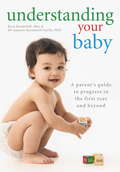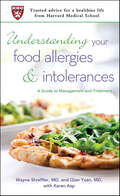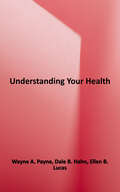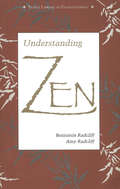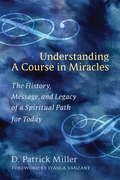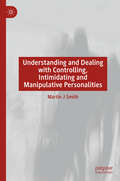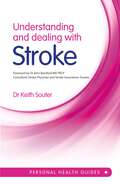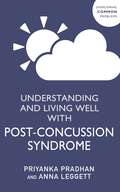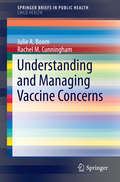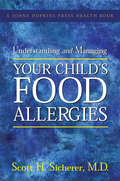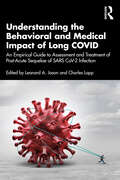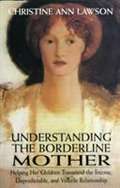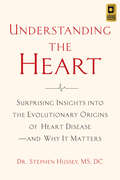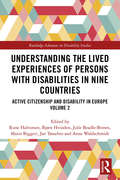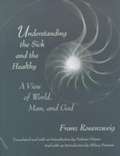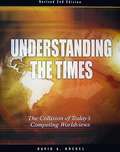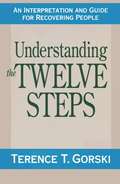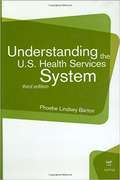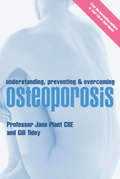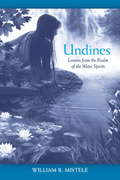- Table View
- List View
Understanding Your Baby: A parent's guide to early child development
by Annette Karmiloff-Smith Kyra KarmiloffBabies arrive in the world already equipped with many skills, reflexes and instincts that help them adapt to and influence their environment as well as the people who fill it. The mother-and-daughter team of Kyra Karmiloff, a research psychologist, and Dr Annette Karmiloff-Smith, a professorial research fellow at the Developmental Neurocognition Lab at Birkbeck College, University of London, 'translate' the latest scientific findings on infant behaviour, the development of gross and fine motor skills and intelligence, and how infants produce language and experience the social world, as well as offering helpful tips and suggestions about how parents can positively influence their child's journey towards independence.
Understanding Your Baby: A parent's guide to early child development
by Annette Karmiloff-Smith Kyra KarmiloffBabies arrive in the world already equipped with many skills, reflexes and instincts that help them adapt to and influence their environment as well as the people who fill it. The mother-and-daughter team of Kyra Karmiloff, a research psychologist, and Dr Annette Karmiloff-Smith, a professorial research fellow at the Developmental Neurocognition Lab at Birkbeck College, University of London, 'translate' the latest scientific findings on infant behaviour, the development of gross and fine motor skills and intelligence, and how infants produce language and experience the social world, as well as offering helpful tips and suggestions about how parents can positively influence their child's journey towards independence.
Understanding Your Food Allergies and Intolerances: A Guide to Management and Treatment
by Qian Yuan Karen Asp Wayne ShrefflerA guide to understanding and handling food allergies and sensitivities A comprehensive overview of food sensitivities, including food allergies and food intolerances. The authors clear up much of the confusion consumers have about food sensitivities as they help food-sensitive individuals understand their symptoms, manage their condition and learn to enjoy eating again. Features: - Listing of most common food allergies- Examination of the differences between allergies and intolerances- Discussion of where to look for hidden food allergens- Case studies of various allergic reactions- Questions to ask your doctor- Guide to traveling with food allergies - Quiz for when to get tested - A look at new and future treatments for food sensitivity
Understanding Your Health
by Dale B. Hahn Wayne A. Payne Ellen B. LucasThis book offers an exciting and practical approach to the teaching of the traditional content areas of personal health. Its two key themes - the six dimensions of health and the five developmental tasks - help students apply the text's content to their own lives, by improving their decision-making skills. The strength of the Understanding Your Health narrative includes its appeal to both traditional and non-traditional students, particularly the special attention it pays to students over age 25 who have returned to college. <p><p>In addition, among its many health assessment activities, Understanding Your Health includes one of the most comprehensive health assessments found in any personal health textbook - a great tool for establishing a health baseline for students. The companion Online Learning Center (website) offers a wealth of pedagogical and assessment features, including quizzes, Internet activities, downloadable MP3s, and more.
Understanding Zen
by Benjamin Radcliff Amy Radcliff"The authors of this book, who both have university affiliations, present Zen as a "secular doctrine without any necessary relationship to Buddhism or Eastern culture." Some of the seven chapters deal with such concepts as reason, paradox, meaning, and existence and how they relate to Zen. Others explore successfully the origin of Zen, the practice of meditation, and the social implications of Zen. The authors also investigate the Taoist and Buddhist ideas preceding Zen and relate it to Freudian psychology, anarchism, and the dualistic truths of the scientific method. Though this well-done study is accessible to informed lay readers, it is more suitable for academic libraries."--Library Journal
Understanding a Course in Miracles
by Iyanla Vanzant D. Patrick MillerThis comprehensive introduction to the grassroots phenomenon A Course in Miracles covers the book's role in America's changing spiritual landscape, investigates its origins and history, and explains its principal tenets and philosophies. Weaving together extensive research and student perspectives, journalist D. Patrick Miller sheds light on the provocative and oft-misunderstood text. An examination of the teachings and influence of A Course in Miracles, one of the most popular and controversial texts in contemporary spirituality. With a new foreword by Iyanla VanzantCovers common questions, such as What exactly is the Course? Is it Christian, Buddhist, New Age, or something else entirely? How did the author channel the message? More than two million copies of A Course in Miracles available worldwide in 19 languages, with thousands of study groups devoted to it. From the Trade Paperback edition.
Understanding and Dealing with Controlling, Intimidating and Manipulative Personalities
by Martin J SmithThis book will examine at individuals who control, intimate, and manipulate in work, home, family, and social environments, using robust Psychological theory to comprehend and successfully tackle those who exhibit these behaviours. The focus of this book will be to look at general Personality theory together with more specific focus on the Dark Triad of personality traits and, from the Five Factor Model, the domain of Agreeableness vs Antagonism. This approach will build a greater understanding of a much broader form of controlling intimidating and manipulative personality type. The book will include both useable techniques as well as self-reflection exercises the reader can use or pass on to students, clients and service users. This book is based on a programme the author has been teaching for over twelve years to a range of audiences across a variety of roles and has also been highlighted frequently in the press over the past decade.
Understanding and Dealing with Depression
by Keith SouterDepression affects 1 in 5 adults at some point during their lives, and for many people it can seriously affect their quality of life, as well as having a significant effect on family and friends. This book gives the basic information needed to understand what depression is, how to recognise it, and, most essentially, how to deal with it.
Understanding and Dealing with Stroke
by Keith SouterIt is estimated that there are up to 30 strokes every minute throughout the world. This book gives the basic information needed to understand what a stroke is, how to spot the risk factors that may contribute to a stroke, and how to take steps to deal with the repercussions.
Understanding and Living Well With Post-Concussion Syndrome
by Priyanka Pradhan Anna LeggettConcussion, even in its mildest form, can have lasting effects on the individual in a way we're only just beginning to understand. Mild Traumatic Brain Injuries (mTBI), concussion and post-concussion syndrome have previously been conservatively managed with recommendations for 'rest'. But even mild brain injuries and post-concussion syndrome can have an enormous impact on life, long after the 3 months during which they are expected to resolve. There are also significant differences between the way in which concussion affects men and women respectively, as this new research shows. If concussion or an mTBI are affecting you, there is much in this book to help and support your symptoms. Neuropsychologist Dr Priyanka Pradhan has pulled together the latest research to provide a complete manual for overcoming the impact of any mild brain injury, while writer and coach Anna Leggett gives deep insight from her own experiences with post-concussion syndrome. Their book not only explains what a concussion is and how it may present, but also gives comprehensive practical strategies for managing persistent symptoms. Such strategies include how to ask for professional and specialist medical help (and where to get it from), and also self-management techniques that draw on things like EMDR, craniosacral therapy and osteopathy. Understanding and Living Well with Post-Concussion Syndrome also explains the importance of sleep and diet, and includes significant psychological and emotional support for mental wellbeing and recovery, a support that is often missing from the clinical pathway for post-concussion syndrome. This book is an essential resource for anyone who feels that they need insight, practical help and emotional support into what is often perceived as an almost-invisible illness, but one which is very real for you or your loved one.
Understanding and Living Well With Post-Concussion Syndrome
by Priyanka Pradhan Anna LeggettConcussion, even in its mildest form, can have lasting effects on the individual in a way we're only just beginning to understand. Mild Traumatic Brain Injuries (mTBI), concussion and post-concussion syndrome have previously been conservatively managed with recommendations for 'rest'. But even mild brain injuries and post-concussion syndrome can have an enormous impact on life, long after the 3 months during which they are expected to resolve. There are also significant differences between the way in which concussion affects men and women respectively, as this new research shows. If concussion or an mTBI are affecting you, there is much in this book to help and support your symptoms. Neuropsychologist Dr Priyanka Pradhan has pulled together the latest research to provide a complete manual for overcoming the impact of any mild brain injury, while writer and coach Anna Leggett gives deep insight from her own experiences with post-concussion syndrome. Their book not only explains what a concussion is and how it may present, but also gives comprehensive practical strategies for managing persistent symptoms. Such strategies include how to ask for professional and specialist medical help (and where to get it from), and also self-management techniques that draw on things like EMDR, craniosacral therapy and osteopathy. Understanding and Living Well with Post-Concussion Syndrome also explains the importance of sleep and diet, and includes significant psychological and emotional support for mental wellbeing and recovery, a support that is often missing from the clinical pathway for post-concussion syndrome. This book is an essential resource for anyone who feels that they need insight, practical help and emotional support into what is often perceived as an almost-invisible illness, but one which is very real for you or your loved one.
Understanding and Managing Vaccine Concerns
by Julie A. Boom Rachel M. CunninghamSmallpox, measles, diphtheria, polio: vaccines have diminished their power, and in some cases, eradicated these dreaded diseases. Yet this century has seen growing numbers of parents refusing vaccinations for their children, not only endangering them but also increasing the risk of outbreaks and epidemics of vaccine-preventable diseases. Understanding and Managing Vaccine Concerns concisely explains the evolution of vaccine concerns, and gives clinicians hands-on help in dealing with vaccine hesitation and outright refusal among parents. Persistent themes in refusal, such as a supposed autism/vaccine link and the belief that too many vaccines are given too soon, are discussed and recent statistics given for trends in vaccine refusal and delay. Central to the book is a detailed guide to vaccine concern management, with sample responses that readers can tailor to address vaccine refusal and specific concerns regarding individual vaccines and their components. This thorough grounding will assist providers in countering misinformation with facts and allaying fears with medically and ethically sound responses. Included in this practical resource: A brief history of vaccine concerns. Current trends in vaccine hesitancy and refusal. Health implications of vaccine refusal. Characteristics and beliefs of vaccine-concerned parents. The CASE approach: a management strategy for vaccine concerns. Additional considerations in management strategies. The debate over vaccination isn't going away any time soon and neither is the potential threat to public health, making Understanding and Managing Vaccine Concerns a timely and necessary addition to the libraries of pediatricians, nurses and other healthcare providers.
Understanding and Managing Your Child's Food Allergies (A Johns Hopkins Press Health Book)
by Scott H. SichererFor children with food allergies, eating—one of the basic functions of life—can be a nightmare. Children who suffer or become dangerously ill after eating peanuts, seafood, milk, eggs, wheat, or a host of other foods require constant vigilance from caring, concerned parents, teachers, and friends.In this empathetic and comprehensive guide, Dr. Scott H. Sicherer, a specialist in pediatric food allergies, gives parents the information they need to manage their children’s health and quality of life. He describes why children develop food allergy, the symptoms of food allergy (affecting the skin, the gastrointestinal tract, and the respiratory system), and the role of food allergy in behavioral problems and developmental disabilities. Parents will learn how to recognize emergency situations, how to get the most out of a visit with an allergist, what allergy test results mean, and how to protect their children—at home, at school, at summer camp, and in restaurants.Informative, compassionate, and practical, this guide will be indispensable for parents, physicians, school nurses, teachers, and everyone else who cares for children with food allergies.
Understanding the Behavioral and Medical Impact of Long COVID: An Empirical Guide to Assessment and Treatment of Post-Acute Sequelae of SARS CoV-2 Infection
by Leonard A. Jason and Charles LappUnderstanding the Behavioral and Medical Impact of Long COVID serves to expand the research around the illness in order to enable health care researchers and practitioners to address the questions that are imperative to individuals suffering from this condition. Through its multi-faceted approach, the book puts forth a maturation of research and interventions that are theoretically sound, empirically valid, innovative, and creative in the Long COVID area. As a scholarly and scientific compilation of Long COVID symptoms and related disorders, this book offers unparalleled insight into the critical developments across medical areas treating this illness. It helps to fill the space that the pandemic had created for knowledge of the condition, and contributes to the emerging emphasis on translational research blending the social sciences and biological fields. By putting forth the most optimal medical care practices in the treatment of complex Long COVID symptoms, this practical anthology will serve as a guide for practicing clinicians in assessment as well as treatment. It will also benefit researchers aiming to gain more understanding of Long COVID through its discussion around the critical developments in other medical areas treating the condition, and paves the way for the collaboration and future research needed to best support the global effort to mitigate the effects of this illness. This book will be essential reading for academics, practitioners, and researchers. It will appeal to individuals engaging with the fields of medicine, public policy, psychology, and for researchers looking to gain clarity about our current understanding of Long COVID. It will further be of interest to public/government agencies, nonprofit organizations, and the general public wanting to gain more information about these ambiguous and evasive symptoms.
Understanding the Borderline Mother: Helping Her Children Transcend the Intense, Unpredictable, and Volatile Relationship
by Christine Ann LawsonSome readers may recognize their mothers as well as themselves in this book. They will also find specific suggestions for creating healthier relationships. Addressing the adult children of borderlines and the therapists who work with them, Dr. Lawson shows how to care for the waif without rescuing her, to attend to the hermit without feeding her fear, to love the queen without becoming her subject, and to live with the witch without becoming her victim.
Understanding the Heart: Surprising Insights into the Evolutionary Origins of Heart Diseaseand Why It Matters
by Stephen Hussey*Foreword INDIES Book of the Year Award Finalist for Health&“The most mind-blowing information on heart disease. . . . I consider this to be one of the best books I&’ve ever read on cardiovascular health.&”—Ben Greenfield, New York Times bestselling authorHeart disease is the number-one killer in the world. Despite ever-advancing medical procedures and more and more powerful pharmaceutical drugs, the rate of heart disease continues to rise.According to Dr. Stephen Hussey, this is due in part to misunderstandings about how the heart really functions and how to keep it healthy. These misunderstandings result in improper medical approaches and off-target intervention therapies.As a type 1 diabetic, Dr. Hussey has always known that he was at two to four times greater risk of developing heart disease. As a result, he has dedicated his entire adult life to understanding the heart, to prevent himself from becoming a statistic.And then his worst nightmare came true. Dr. Hussey suffered a &“STEMI,&” a blockage in the left anterior descending artery of his heart. STEMIs are typically so fatal that they are known as &“widowmakers.&” Only 12 percent of those who experience them outside of a hospital setting survive.Dr. Hussey was among the lucky 12 percent, but faced a difficult decision during his recovery: follow the standard of care laid out for him by the attending cardiologist, or politely decline and apply everything he&’d learned about the heart to a recovery protocol that would look massively different than what the doctors were recommending.In Understanding the Heart, Dr. Hussey shares the information that guided him through the highest-stakes decision of his life, including:A large body of research suggesting that the heart is not the main mover of blood in the body, and what that means for your overall healthThe evolutionary origins of the nervous system, and how these manifest today in rampant rates of heart diseaseDeep analysis of the widely accepted idea that saturated fat and cholesterol will clog your arteriesThe importance of reducing oxidative stress for a heart healthy lifestyleIn Understanding the Heart, Dr. Stephen Hussey lays bare everything he has learned in his deep investigation into the heart, and guides you on a path to prevent disease in the context of a highly diseased modern world in order to enjoy lifelong good health.
Understanding the Heart: Surprising Insights into the Evolutionary Origins of Heart Disease—and Why It Matters
by Doctor Stephen Hussey“The most mind-blowing information on heart disease. . . . I consider this to be one of the best books I’ve ever read on cardiovascular health.”—Ben Greenfield, New York Times bestselling author Heart disease is the number-one killer in the world. Despite ever-advancing medical procedures and more and more powerful pharmaceutical drugs, the rate of heart disease continues to rise. According to Dr. Stephen Hussey, this is due in part to misunderstandings about how the heart really functions and how to keep it healthy. These misunderstandings result in improper medical approaches and off-target intervention therapies. As a type 1 diabetic, Dr. Hussey has always known that he was at two to four times greater risk of developing heart disease. As a result, he has dedicated his entire adult life to understanding the heart, to prevent himself from becoming a statistic. And then his worst nightmare came true. Dr. Hussey suffered a “STEMI,” a blockage in the left anterior descending artery of his heart. STEMIs are typically so fatal that they are known as “widowmakers.” Only 12 percent of those who experience them outside of a hospital setting survive. Dr. Hussey was among the lucky 12 percent, but faced a difficult decision during his recovery: follow the standard of care laid out for him by the attending cardiologist, or politely decline and apply everything he’d learned about the heart to a recovery protocol that would look massively different than what the doctors were recommending. In Understanding the Heart, Dr. Hussey shares the information that guided him through the highest-stakes decision of his life, including: A large body of research suggesting that the heart is not the main mover of blood in the body, and what that means for your overall health The evolutionary origins of the nervous system, and how these manifest today in rampant rates of heart disease Deep analysis of the widely accepted idea that saturated fat and cholesterol will clog your arteries The importance of reducing oxidative stress for a heart healthy lifestyle In Understanding the Heart, Dr. Stephen Hussey lays bare everything he has learned in his deep investigation into the heart, and guides you on a path to prevent disease in the context of a highly diseased modern world in order to enjoy lifelong good health.
Understanding the Human Foot: An Illustrated Guide to Form and Function for Practitioners
by James EarlsAn essential resource for bodyworkers, physical therapists, and sports medicine practitioners--a vital guide to understanding the anatomy, form, and mechanics of the human foot.Understanding the Human Foot is a full-color, up-to-date overview of the structure and function of the foot, written for physical therapists and movement practitioners looking to deepen their understanding of holistic anatomy. Readers will gain perspective on the impacts of foot shape; the interdependence of form and function; and the cellular processes that determine how our tissue is designed. Most importantly, author James Earls demonstrates how the foot relates to and interacts with the rest of the body during movement, laying the groundwork for a comprehensive holistic approach to assessing, troubleshooting, and addressing functional and structural foot issues.Starting with big-picture questions--what is a foot, and what is it used for? How does it work, both on its own and as part of a whole?--before zeroing in on the 26 bones, 33 joints, and many muscles that make up the foot, Earls teaches anatomy the way he wishes he'd been taught 30 years ago: with a holistic emphasis on interrelated systems, real-life applications, and approachable, easy-to-understand language. He shares: • Full-color illustrations for easy reference and comprehensive understanding • An overview of the bones, ligaments, and extrinsic and intrinsic muscles of the foot • How your gait impacts the rest of the body--and can cause problems as high up as the neck and shoulders • How to assess structural problems of the foot • Corrective exercises • A footwear guide to choosing the best shoe for your foot type
Understanding the Lived Experiences of Persons with Disabilities in Nine Countries: Active Citizenship and Disability in Europe Volume 2 (Routledge Advances in Disability Studies)
by Mario Biggeri Rune Halvorsen Bjørn Hvinden Julie Beadle Brown Jan Tøssebro Anne WaldschmidtOver the last three decades, a number of reforms have taken place in European social policy with an impact on the opportunities for persons with disabilities to be full and active members of society. The policy reforms have aimed to change the balance between citizens’ rights and duties and the opportunities to enjoy choice and autonomy, live in the community and participate in political decision-making processes of importance for one’s life. How do the reforms influence the opportunities to exercise Active Citizenship? This volume presents the findings from the first cross-national comparison of how persons with disabilities reflexively make their way through the world, pursuing their own interests and values. The volume considers how their experiences, views and aspirations regarding participation vary across Europe. Based on retrospective life-course interviews, the volume examines the scope for agency on the part of persons with disabilities, i.e. the extent to which men and women with disabilities are able to make choices and pursue lives they have reasons to value. Drawing on structuration theory and the capability approach, the volume investigates the opportunities for exercising Active Citizenship among men and women in nine European countries. The volume identifies the policy implications of a process-oriented and multi-dimensional approach to Active Citizenship in European disability policy. It will appeal to policymakers and policy officials, as well as to researchers and students of disability studies, comparative social policy, international disability law and qualitative research methods.
Understanding the Sick and the Healthy: A View of World, Man, and God
by Franz RosenzweigFranz Rosenzweig, one of the century's great Jewish thinkers, wrote his gem of a book in 1921 as a more accessible precis of his famous Star of Redemption. An elegant introduction to Rosenzweig's "new thinking," Understanding the Sick and the Healthy was written for a lay audience and takes the form of an ironic narrative about convalescence. With superb simplicity and beauty, it puts forth an important critique of the nineteenth-century German Idealist philosophical tradition and expresses a powerful vision of Jewish religion. Harvard's Hilary Putnam provides a new introduction to this classic work for a contemporary audience.
Understanding the Times: The Collision of Today's Competing Worldviews (Revised 2nd edition)
by David NoebelComparison of Christianity vs. Islam, Secular Humanism, Marxism, Cosmic Humanism, and Postmodernism in the areas of theology, philosophy, ethics, biology, psychology, sociology, law, politics, economics, and history.
Understanding the Twelve Steps: An Interpretation and Guide for Recovering People
by Terence T. GorskiMillions of people have transformed their lives by working the Twelve Steps of Alcoholics Anonymous. Their success has come from their ability to truly understand these principles and to apply them in their daily lives. Yet for many embarking on the road to recovery, the Steps can seem vague, even confusing. This practical, no-nonsense guide takes the mystery out of the Twelve Steps, presenting a straightforward explanation of what each step means, as well as examples of how it translates to real life. Written by a certified alcoholism and drug abuse counselor with more than twenty years of experience, it offers a wealth of wisdom, knowledge, and genuine support for anyone in recovery. Understanding the Twelve Steps features: Clear, easy-to-understand interpretation of the Twelve Steps -- the vital building blocks of recovery Checklists that summarize the tasks and objectives of each step The Twelve Promises -- the positive changes you can expect in your life if you follow the Twelve Steps What happens at Twelve Step meetings and why it is important to have a sponsor The experiences, strength, and hope of other recovering people
Understanding the U.S. Health Services System (3rd Edition)
by Phoebe Lindsey BartonThis comprehensive book is the definitive text on how the U.S. health services system is organized and financed. The text addresses each aspect of system organization, management, financing, resource production, and delivery components.
Understanding, Preventing and Overcoming Osteoporosis
by Gillian Tidey Jane Plant CBEWith the help of this book you can:* Learn how to prevent osteoporosis* Improve your chances of increasing your bone strength and health if you suffer from osteoporosis* Discover how to get the best out of othodox medicine* Educate yourself about the fundamental importance of diet and lifestyle, with seven Food Factors and eight Lifestyle Factors, aimed at improving your bone health, appearance and outlook.* Follow a new dietary regime based on delicious recipes* Above all, discover a diet and lifestyle that will empower you to prevent and combat the disease.
Undines: Lessons from the Realm of the Water Spirits
by William R. MisteleUndines-from the Latin root unda, which means “wave”- are water elementals, or spirits of the water world. Like their fellow elementals-salamanders (fire), sylphs (air), and gnomes (earth)-undines are united with, and personify, their element. First mentioned in the alchemical works of medieval botanist Paracelsus, undines appear throughout European folklore. Who are these mysterious creatures of lakes, oceans, and waterfalls? Undines takes readers directly into the water spirits’ realm through stories, personal encounters, and interviews with such luminaries as Istiphul, the undine queen whose presence embodies the magical essence of the feminine. Whether seen as fact or fairy tale, Undines presents archetypal truths and insights into human nature. The powers and abilities that undines display are latent in us all and crucial to humanity’s evolution (or mere survival): harmony with nature, empathy and compassion, a deep capacity to love, and a cooperative rather than combative relationship to the world. Undines will appeal broadly to readers of mythology, fantasy, and fairy tales, particularly to practitioners that work with nature spirits and elemental beings-Druids, Wiccans, pagans, and those interested in magic and mysticism.
